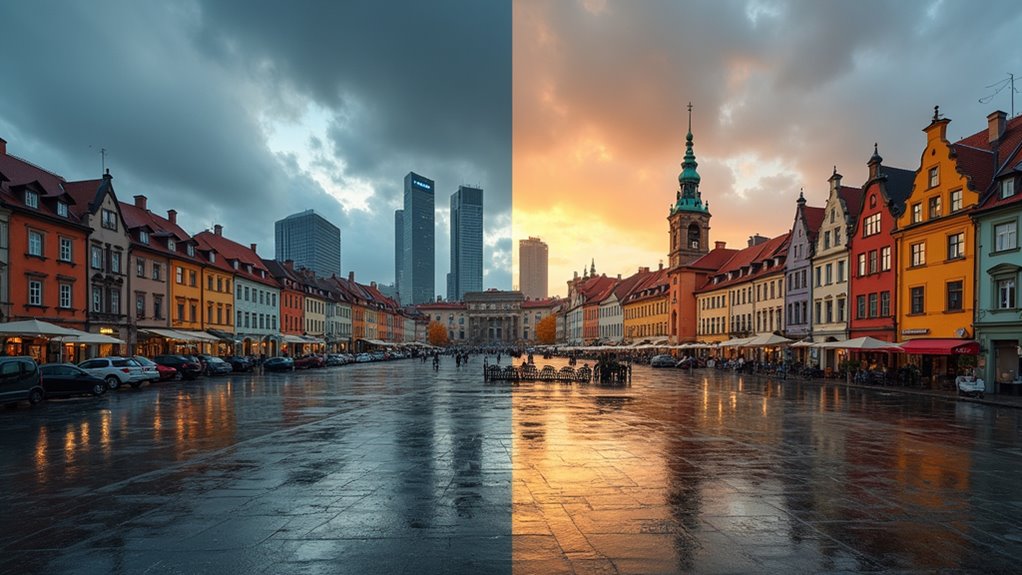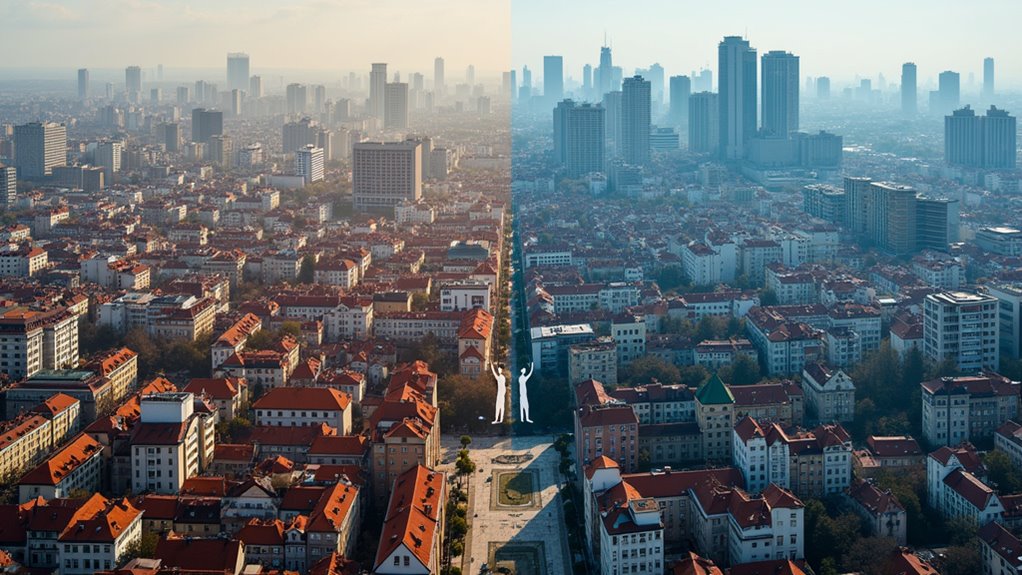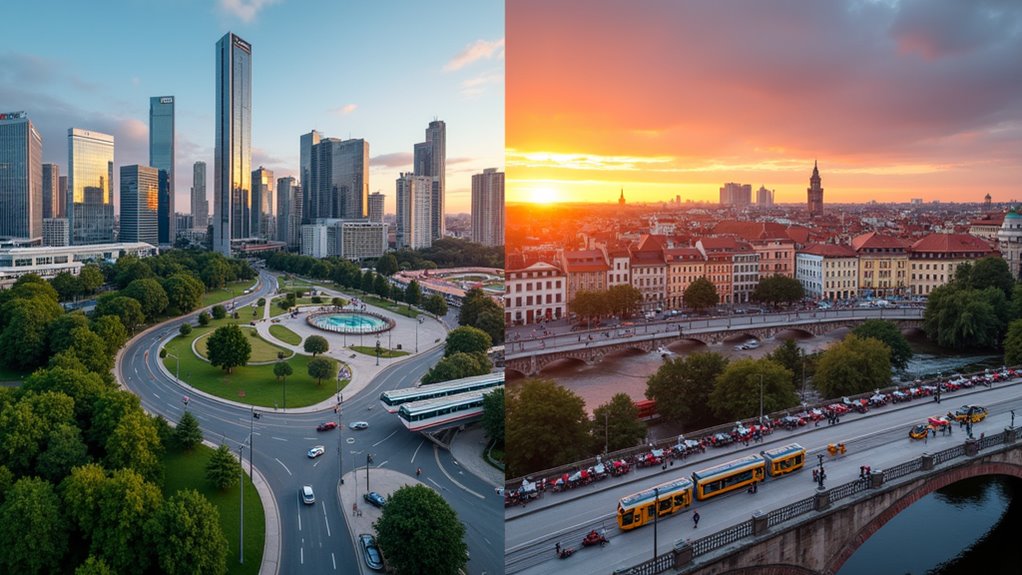Physical Address
304 North Cardinal St.
Dorchester Center, MA 02124
Physical Address
304 North Cardinal St.
Dorchester Center, MA 02124

Historic Polish cities Warsaw and Wroclaw battle for supremacy - which offers better living, culture, and opportunities?
Warsaw and Wroclaw offer distinct Polish urban experiences. Warsaw, with 1.75 million residents, provides a bustling capital atmosphere with higher salaries but 10-17% higher living costs. Wroclaw, home to 642,000 people, delivers a more intimate setting with better air quality, more green spaces, and lower housing prices. Your preference might depend on whether you value Warsaw’s economic opportunities and cultural diversity or Wroclaw’s walkability and affordability. Both cities showcase Poland’s opulent contrasts.

When comparing Warsaw and Wroclaw, the population numbers immediately highlight the stark contrast between Poland’s bustling capital and its fourth-largest city. Warsaw houses approximately 1.75 million residents, while Wroclaw is home to roughly 642,000 people – a difference of over 1.1 million inhabitants.
You’ll feel this population gap in everyday life. Warsaw’s larger size translates to higher urban density, more diverse job markets, and expanded cultural offerings. According to Wikipedia, 2025 data, these population figures directly influence the economic opportunities available in each city. The capital’s extensive infrastructure and public services reflect its status as Poland’s economic powerhouse.
Meanwhile, Wroclaw offers a more intimate community feel while still functioning as a significant regional hub. Much like how European destinations vary dramatically in population density, the two Polish cities present distinctly different urban experiences. Despite its smaller size, it maintains substantial economic influence in southwestern Poland and provides a balance between urban amenities and manageable city living.
Beyond their current sizes, Warsaw and Wroclaw’s contrasting historical paths have shaped their modern identities. While Wroclaw boasts over 1,000 years of history as Silesia’s capital, Warsaw’s significance emerged later in the 16th and 17th centuries.
Two cities, two stories—one ancient Silesian capital, one medieval newcomer that became Poland’s heart.
You’ll find Wroclaw’s evolution marked by multicultural influences from its position on trade routes like the Via Regia. The city underwent significant German cultural influence, with Polish usage disappearing from official documents by the 14th century. The medieval city’s population was remarkably diverse, consisting of Poles, Bohemians, Germans, Walloons, and Jews, reflecting its importance as a regional crossroads.
Meanwhile, Warsaw developed as Poland’s cultural heart, making it a deliberate target for destruction during World War II.
Post-war, these cities took different approaches: Warsaw focused on reconstructing its destroyed heritage, while Wroclaw began integrating its complex past—including its German heritage—into its development, now positioning itself as Poland’s technological hub. Despite their rich history, both cities remain relatively affordable compared to other European destinations, offering travelers excellent value for money while exploring their unique heritage.

Although both cities represent Poland’s urban landscape, Warsaw and Wroclaw display distinct age demographic profiles that markedly impact their character and development. Warsaw’s median age of 43 years slightly exceeds Wroclaw’s 41.7, reflecting different urban environments.
Wroclaw’s vibrant, youthful atmosphere stems from its impressive student population—over 130,000 young people inject energy into the city’s cultural scene. This academic presence helps counterbalance Poland’s aging population trend. This demographic variation showcases how geographic differences influence regional development strategies across Polish urban centers.
Meanwhile, Warsaw offers a more diverse age mix with robust opportunities for young professionals alongside established senior communities. Both cities face the challenge of accommodating senior needs, with Wroclaw’s senior population growing from 21.5% to 24.2% between 2013-2018. Similar to the iconic city comparison between London and New York, these Polish urban centers each have their own distinctive character and appeal.
When choosing between these cities, consider whether you prefer Wroclaw’s youthful university vibe or Warsaw’s broader demographic balance.
The urban landscapes of Warsaw and Wrocław reveal two distinctly different approaches to city development, with each metropolis showcasing unique planning philosophies shaped by their historical contexts.
Warsaw’s layout reflects its status as Poland’s capital with higher population density (3,326 people/km²) and a more extensive urban grid.
You’ll notice Warsaw’s characteristic mix of densely packed tenement houses from the 19th century alongside modern office developments—part of the city’s dynamic strategy to attract businesses.
Wrocław offers a more manageable urban experience with lower population density (2,160 people/km²) and a more walkable layout.
While both cities maintain beautiful public spaces and historical preservation efforts, Warsaw’s are more extensive due to its larger historical footprint and resources as the capital.
Warsaw’s exceptional walkability score of 9.4/10 makes it particularly accessible for pedestrians despite its much larger total surface area.
Unlike Denmark’s warmest spots, both Polish cities experience similar continental climate patterns with four distinct seasons.

Moving from the physical structure of these Polish cities to their economic foundations reveals another layer of contrast and competition. Warsaw functions as Poland’s undisputed financial heart, dominating in banking, business services, and hosting a vibrant startup ecosystem. You’ll find higher salaries here, reflecting its capital status and broader economic base.
Wroclaw counters with impressive strength in manufacturing, particularly automotive and electronics sectors, while building a solid reputation in logistics due to its strategic location.
Both cities boast thriving IT industries and actively court foreign investment with various incentives. The technology sector has become particularly important, contributing significantly to GDP growth in both urban centers.
If you’re job hunting, Warsaw offers more diverse opportunities across sectors, while Wroclaw provides strong prospects in tech, manufacturing, and logistics.
Each city’s universities supply skilled graduates, fueling their respective economic engines and innovation capabilities. For travelers contemplating a broader European journey, these Polish cities provide excellent starting points for Eastern European exploration before potentially heading west to destinations like Portugal.
Both cities offer affluent cultural landscapes that reflect Poland’s artistic heritage while embracing contemporary creative expressions. Warsaw boasts the extensive National Museum with 800,000+ items and the thought-provoking Uprising Museum.
Meanwhile, Wroclaw fascinates with the WRO Art Center‘s innovative media installations and the historical Panorama of Racławice.
When it comes to cultural events, you’ll find distinct flavors in each city:
Both cities feature vibrant nightlife scenes, with Warsaw’s Mokotow district and Wroclaw’s riverside venues catering to different tastes

After experiencing the vibrant cultural scenes of Warsaw and Wroclaw, your wallet might wonder which city offers better financial value. The numbers tell a clear story: Warsaw is 10-17% more expensive overall, with housing driving most of the difference.
You’ll need about 17,294 zł monthly in Warsaw versus 15,000 zł in Wroclaw for comparable lifestyles. Warsaw’s apartments cost roughly 20% more, while restaurants charge 20-26% higher prices for similar meals. The average net salary in Warsaw is 25.7% higher than in Wroclaw, which helps offset some of the increased costs.
Even childcare (28% pricier) and fitness memberships (15-20% more) stretch your budget further in the capital.
Transportation follows the pattern, with Warsaw’s monthly passes costing 10-15% more than Wroclaw’s. The silver lining? Groceries occasionally show slightly lower costs in Warsaw, though this varies by item. For travelers comparing costs between Polish and Croatian destinations, Zagreb’s affordability makes it a budget-friendly alternative to both Warsaw and Wroclaw.
When choosing between Warsaw and Wrocław, you’ll want to think about how you’ll get around within each city and between them if needed. Both cities offer extensive public transportation systems with buses and trams for local travel.
For intercity travel, you have multiple options:
Cost-conscious travelers should note that buses start at zł 120, while trains range from zł 60-100, making them more economical than flying. Bus tickets can be secured for as low as $6 when booking in advance, which is recommended for guaranteed seats. Similar to planning a European getaway between countries like Spain and France, having transportation options gives you flexibility when exploring Polish cities.

Deciding between Warsaw and Wrocław ultimately comes down to your lifestyle priorities and what you value most in a city.
Your budget will stretch further in Wrocław, with overall costs running 13-17% lower than Warsaw, particularly in housing where you’ll save about 20%.
Warsaw offers more specialized healthcare services and potentially better shopping options, though you’ll pay about 23% more for clothing. For foodies, Warsaw provides more restaurants featuring Swedish cuisine with traditional dishes like köttbullar and gravlax.
While both cities maintain high safety standards, Warsaw’s larger population brings slightly higher crime rates.
If environmental quality matters to you, Wrocław’s abundant green spaces and better air quality give it an edge. Both cities experience similar traffic efficiency, with commute time indices nearly identical at around 34.7.
Both cities provide strong educational institutions and vibrant cultural scenes, though Warsaw’s capital status means more diverse cultural offerings and events throughout the year.
Choosing between Warsaw and Wroclaw isn’t just picking a dot on the map—it’s selecting your daily rhythm. While Warsaw offers metropolitan energy with robust job markets and international connections, Wroclaw delivers a more approachable lifestyle with lower costs and vibrant cultural heritage. You’ll thrive in either city, but your priorities—whether career advancement, quality of life, or culture—will ultimately guide your compass toward your ideal Polish home.